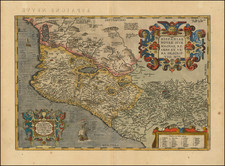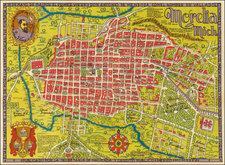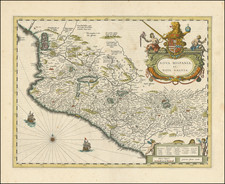Anahuac, or the Empire of Mexico, the Kingdoms of Acolhuacan & Michuacan &c as They Were in the Year 1521
This historical map was published in Philadelphia in 1817, offering a detailed representation of the geographic and political landscapes of Mexico as understood during the early post-conquest period, specifically the year 1521, when the Spanish conquest of the Aztec Empire was completed.
The map is a valuable artifact, reflecting early 19th-century perspectives on pre-Hispanic Mesoamerica and providing insight into the historical regions and kingdoms that once flourished in what is now modern Mexico. This map serves as both a historical document and a pedagogical tool, offering contemporary audiences a window into the pre-Hispanic political landscape of Mexico, giving a snapshot of a pivotal moment in Mesoamerican history, just before the Spanish conquest irrevocably altered the region's political and cultural dynamics.
Anahuac
The term "Anahuac" derives from the Nahuatl language and broadly refers to the territories surrounding the basin of Mexico, particularly the high central plateau. In pre-Columbian times, Anahuac was a general designation for the central part of the Mexican highlands where the Aztec Empire, also known as the Triple Alliance, was centered. The region of Anahuac encompassed the Valley of Mexico, which included the capital city of Tenochtitlan, one of the largest and most powerful cities in Mesoamerica. The use of "Anahuac" in this map signifies the central importance of this region in the political and cultural life of the Aztec Empire, emphasizing its role as the heartland of the empire.
Acolhuacan
Acolhuacan, also known as Acolhuacan or Acolhua, refers to a pre-Columbian Nahua altepetl (city-state) and the corresponding territory in the eastern Valley of Mexico. The Acolhua were one of the three founding members of the Aztec Triple Alliance, alongside Tenochtitlan and Tlacopan. Their capital city was Texcoco, which was a major center of culture and learning in Mesoamerica. Texcoco was renowned for its library, which housed numerous manuscripts, and for its ruler, Nezahualcoyotl, who was celebrated as a philosopher, poet, and engineer. The inclusion of Acolhuacan in the map highlights its significant contribution to the cultural and intellectual heritage of the Aztec civilization.
MichoacanMichoacan refers to the region inhabited by the Purépecha (Tarascan) people, who established one of the most formidable and organized states in pre-Hispanic western Mexico. The Tarascan Empire, centered around the Lake Pátzcuaro basin, was one of the few indigenous states to successfully resist Aztec expansion. The Purépecha were known for their advanced metallurgy, particularly in working with copper and bronze. The capital city, Tzintzuntzan, was a significant center of Tarascan political power and culture. The depiction of Michoacan on this map acknowledges the distinct and influential presence of the Tarascan state in Mesoamerican history, which existed contemporaneously with the Aztec Empire but maintained its independence and unique cultural identity.









![Amer. Sep. No. 70. Partie Du Mexique [Acapulco]](https://storage.googleapis.com/raremaps/img/small/96401.jpg)

![[Baja California, Gulf of California and Sonora] Amer. Sep. No. 58 Partie De La Vieille Californie](https://storage.googleapis.com/raremaps/img/small/62785.jpg)
![Map of Mexico, Central America, and the West Indies [Insets of Bermuda, Cuba, Jamaica and Panama Railroad]](https://storage.googleapis.com/raremaps/img/small/70686.jpg)

